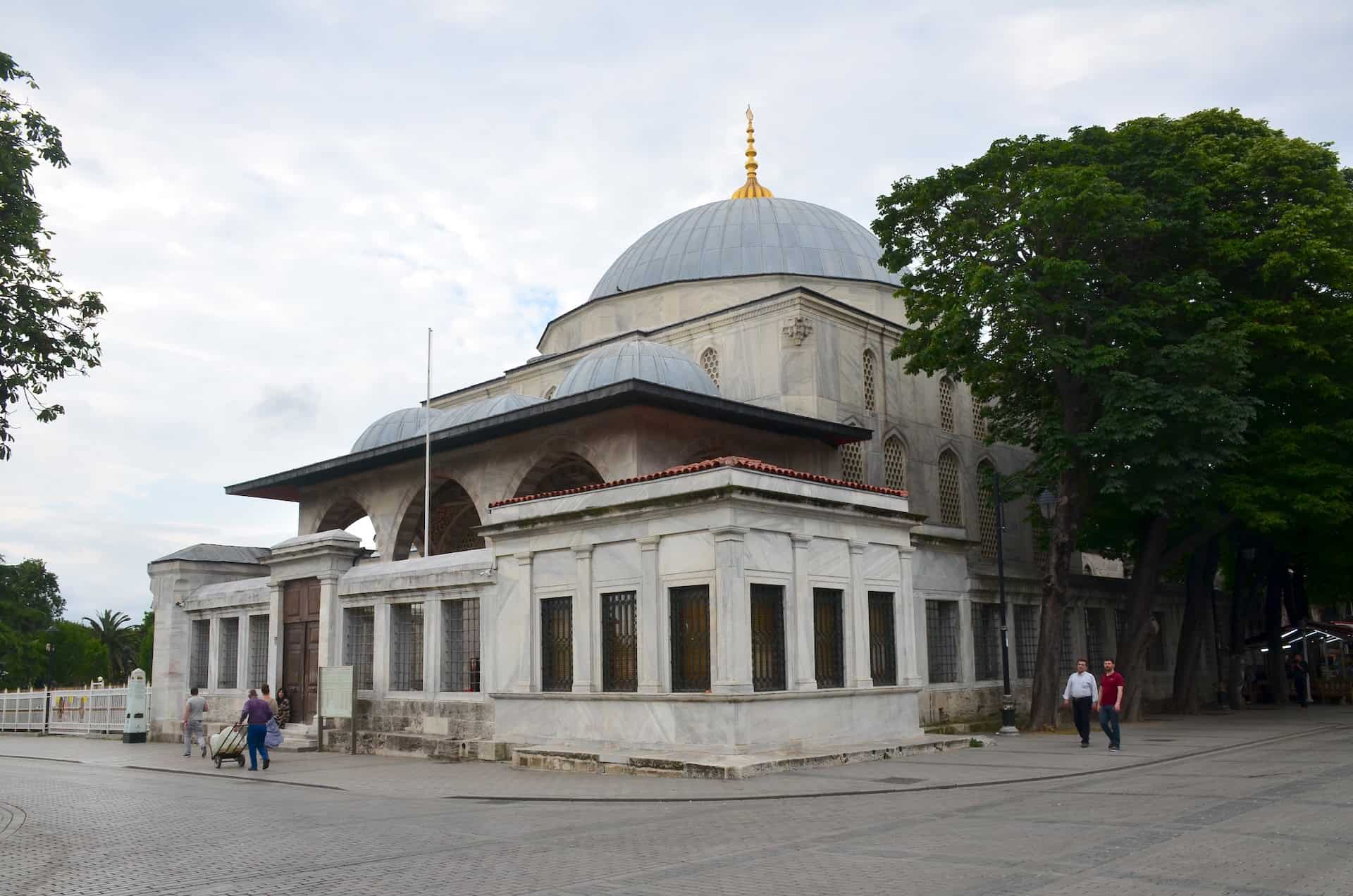Last updated on .
The Tomb of Ahmed I (I. Ahmed Türbesi) sits off the Hippodrome and near the Blue Mosque in the UNESCO World Heritage listed Sultanahmet area of Istanbul.

Introduction to the Tomb of Ahmed I
The Tomb of Ahmed I was commissioned by Ahmed’s younger half-brother, Sultan Mustafa I and built between 1617 and 1619. The architect was Sedefkâr Mehmed Ağa (1540-1617). The building is on a square plan with bevelled corners and the exterior is covered with marble. The entrance is via a triple arched portico through a door decorated with ivory, mother-of-pearl, and tortoise shell inlays. The gate in the front is an addition.
The tomb is topped by a dome and lit by three rows of windows on each side. The windows on the lowest level are rectangular and have wooden frames, while the windows on the upper two rows have pointed arches.
The tomb is decorated with fine Iznik tiles. There are also beautiful examples of Ottoman woodwork, hand drawn decorations, and calligraphy.
Burials in the Tomb of Ahmed I
There are a total of 36 burials inside the Tomb of Ahmed I, including 3 Ottoman sultans and the chief consort of Ahmed I. Their lives are full of tragic tales, power struggles, and deceit. Other burials include the children of Ahmed I, Osman II, Murad IV, and Ibrahim.
Biography of Ahmed I
Ahmed I (b. 1590, Manisa – d. 1617, Constantinople) was the 14th Sultan of the Ottoman Empire (r. 1603-1617). He took the throne at the age of 13 and broke with the Ottoman tradition of fratricide upon his enthronement. Due to several disastrous wars, the Ottoman Empire began to lose territory under his rule.
Ahmed I’s legacy is the construction of the Blue Mosque, and he enjoyed fencing, horseback riding, and poetry. In fact, he authored a number of works under the name Bakhti. Ahmed I died of typhus at Topkapi Palace. Three of his sons, Osman II, Murad IV, and Ibrahim, ascended to the throne.
Biography of Kösem Sultan
Ahmed I is buried next to his wife, Kösem Sultan (1589-1651), also known as Mâh-Peyker Sultan. Originally named Anastasia and the daughter of a Greek Orthodox priest from the island of Tinos, she was kidnapped in 1604 and sold as a slave in Bosnia. The Chief Black Eunuch of the Ottoman court noticed her beauty and intelligence and had her sent to the Imperial Harem to be trained as a concubine.
After being chosen as chief consort, Kösem Sultan quickly rose to become one of the most powerful figures in the history of the Ottoman Empire. As the regent of two Sultans, she effectively controlled important affairs through her influence over them. Kösem Sultan is accused of caring more about her own position of power rather than the interests of the Ottoman Empire. She was assassinated on the orders of her 9-year-old grandson, Mehmed IV, after being accused of a plot against his life.
Biography of Osman II
Nearby is Osman II (b. 1604, Constantinople – d. 1622, Constantinople), the 16th Sultan of the Ottoman Empire (r. 1618-1622). Nicknamed Genç Osman (Young Osman), he was only 14 when he took the throne after a successful coup against his uncle, Mustafa I. During his short reign, he personally led a failed Ottoman invasion of Poland.
Osman II’s son, Şehzade Ömer, was only three months old when he died in the most unusual circumstances. He was struck and killed by a stray bullet that ricocheted during a reenactment of his father’s Poland campaign.
Osman II was the first sultan to recognize the danger of the Janissaries and tried to restrict their power, but they revolted against him. In the end, they dragged him to Yedikule Fortress and strangled him to death, leaving his uncle Mustafa I to take the throne for a second time. It was the first time in history the Janissaries had executed a Sultan.
Biography of Murad IV
Murad IV (b. 1612, Constantinople – d. 1640, Constantinople) is third Sultan buried in the Tomb of Ahmed I. He was the 17th Sultan of the Ottoman Empire (r. 1623-1640). Murad IV was a brutal leader that was only 11 when he took the throne after his uncle, Mustafa I, was deposed for a second time. Nicknamed Murad the Warrior (Murad Gazi), he was the last Ottoman Sultan to lead his troops into battle and fight on the front lines. Rumor has it that on his deathbed from cirrhosis at the age of 27, he ordered the execution of his brother, Ibrahim. This would have ended the Ottoman dynasty, but the order was never carried out.